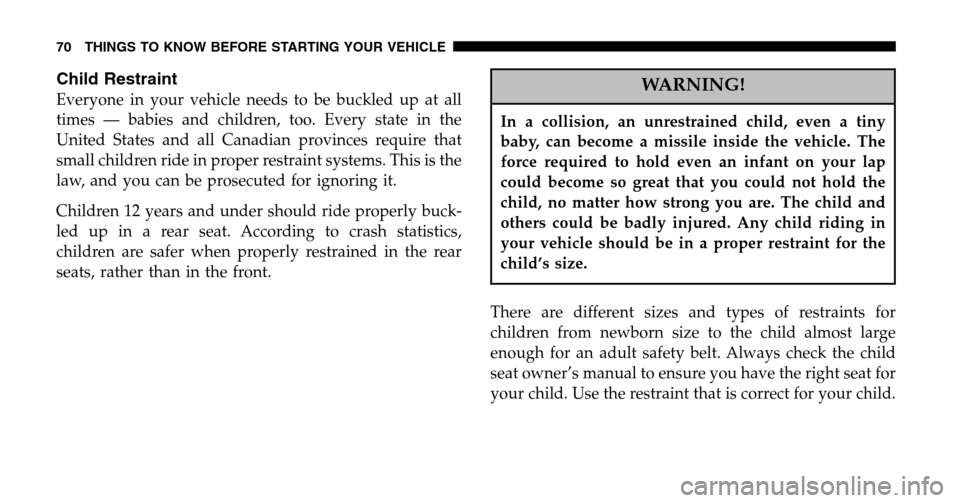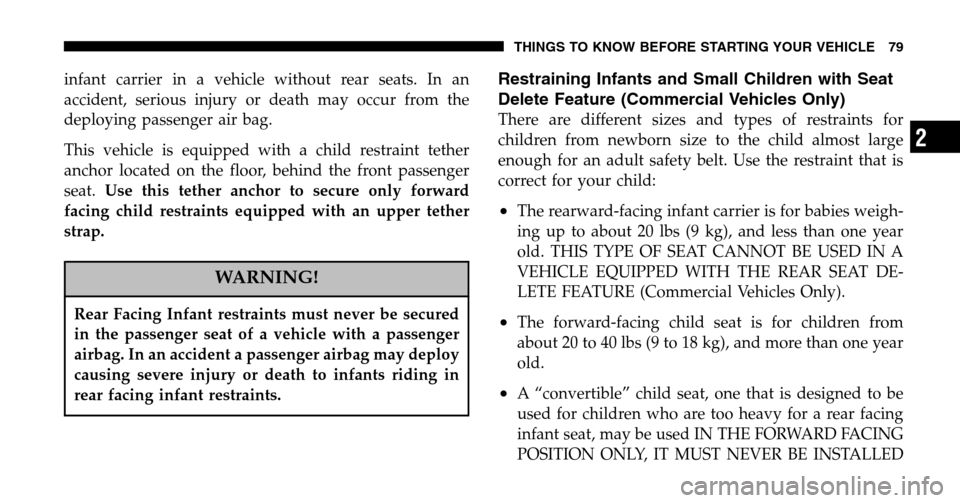Page 70 of 496

Child Restraint
Everyone in your vehicle needs to be buckled up at all
times — babies and children, too. Every state in the
United States and all Canadian provinces require that
small children ride in proper restraint systems. This is the
law, and you can be prosecuted for ignoring it.
Children 12 years and under should ride properly buck-
led up in a rear seat. According to crash statistics,
children are safer when properly restrained in the rear
seats, rather than in the front.WARNING!
In a collision, an unrestrained child, even a tiny
baby, can become a missile inside the vehicle. The
force required to hold even an infant on your lap
could become so great that you could not hold the
child, no matter how strong you are. The child and
others could be badly injured. Any child riding in
your vehicle should be in a proper restraint for the
child’s size.
There are different sizes and types of restraints for
children from newborn size to the child almost large
enough for an adult safety belt. Always check the child
seat owner’s manual to ensure you have the right seat for
your child. Use the restraint that is correct for your child.
70 THINGS TO KNOW BEFORE STARTING YOUR VEHICLE
Page 71 of 496

Infants and Child Restraints
•
Safety experts recommend that children ride
rearward-facing in the vehicle until they are at least
one year old and weigh at least 20 lbs (9 kg). Two types
of child restraints can be used rearward-facing: infant
carriers and �convertible�child seats. Both types of
child restraints are held in the vehicle by the lap/
shoulder belt or the LATCH child restraint anchorage
system. Refer to “Lower Anchors and Tether for CHil-
dren (LATCH)” later in this section.
•The infant carrier is only used rearward-facing in the
vehicle. It is recommended for children who weigh up
to about 20 lbs (9 kg). �Convertible�child seats can be
used either rearward-facing or forward-facing in the
vehicle. Convertible child seats often have a higher
weight limit in the rearward-facing direction than infant carriers do, so they can be used rearward-facing
by children who weigh more than 20 lbs (9 kg) but are
less than one year old.
•Rearward-facing child seats must
NEVERbe used in
the front seat of a vehicle with a front passenger
airbag. An airbag deployment could cause severe
injury or death to infants in this position.
Older Children and Child Restraints
•Children who weigh more than 20 lbs (9 kg) and who
are older than one year can ride forward-facing in the
vehicle. Forward-facing child seats and convertible
child seats used in the forward-facing direction are for
children who weigh 20 to 40 lbs (9 to 18 kg) and who
are older than one year. These child seats are also held
in the vehicle by the lap/shoulder belt or the LATCH
child restraint anchorage system. Refer to “Lower
Anchors and Tether for CHildren (LATCH)” later in
this section.
THINGS TO KNOW BEFORE STARTING YOUR VEHICLE 71
2
Page 72 of 496

•The belt-positioning booster seat is for children weigh-
ing more than 40 lbs (18 kg), but who are still too small
to fit the vehicle’s seat belts properly. If the child can
not sit with knees bent over the vehicles seat cushion
while the child’s back is against the seat back, they
should use a belt-positioning booster seat. The child
and booster seat are held in the vehicle by the lap/
shoulder belt.
Children Too Large For Booster Seats
Children who are large enough to wear the shoulder belt
comfortably, and whose legs are long enough to bend
over the front of the seat when their back is against the
seatback, should use the lap/shoulder belt in a rear seat.
•Make sure that the child is upright in the seat.
•The lap portion should be low on the hips and as snug
as possible.
•Check belt fit periodically. A child’s squirming or
slouching can move the belt out of position.
•If the shoulder belt contacts the face or neck, move the
child closer to the center of the vehicle. If this doesn’t
help, move the child to the center rear seating position
and use the lap belt. Never allow a child to put the
shoulder belt under an arm or behind their back.
NOTE: For additional information, refer to
www.seatcheck.org or call 1-866-SEATCHECK .
72 THINGS TO KNOW BEFORE STARTING YOUR VEHICLE
Page 74 of 496

•In the rear seat, you may have trouble tightening the
lap/shoulder belt on the child restraint because the
buckle or latch plate is too close to the belt path
opening on the restraint. Disconnect the latch plate
from the buckle and twist the short buckle end of the
belt several times to shorten it. Insert the latch plate
into the buckle with the release button facing out.
•If the belt still can’t be tightened, or if pulling and
pushing on the restraint loosens the belt, disconnect
the latch plate from the buckle, turn the buckle
around, and insert the latch plate into the buckle
again. If you still can’t make the child restraint secure,
try a different seating position.
•Buckle the child into the seat according to the child
restraint manufacturer’s directions.
•When your child restraint is not in use, secure it in the
vehicle with the seat belt or remove it from the vehicle.
Don’t leave it loose in the vehicle. In a sudden stop or
collision, it could strike the occupants or seatbacks and
cause serious personal injury.
Lower Anchors and Tether for CHildren (LATCH)
Each vehicle, except commercial cargo vehicles, is
equipped with the child restraint anchorage system
called LATCH, which stands for Lower Anchors and
Tether for CHildren. Two LATCH child restraint anchor-
age systems are installed on all second-row seats and in
the center position on all 3rd row fold-in-floor seats.
Second-row seats also feature tether strap anchorages,
located in the rear surface of the seatback. In addition, all
3-passenger bench seats and 3rd row fold-in-floor seats
are equipped with a child restraint tether anchor at the
center seating position.
74 THINGS TO KNOW BEFORE STARTING YOUR VEHICLE
Page 75 of 496
When using the tether anchorages in the outboard seat-
ing positions, ensure that the strap is routed over the top
of the seatback and under the head restraint between the
head restraint posts. Except for bench seats with split
seatbacks, when the tether anchorage is used in the center
seating position, the strap should be positioned straight over the top of the seatback. For bench seats with split
seatbacks, route the tether between the seatbacks.
When using the tether anchorages in the center position
on 3rd row fold-in-floor seating, ensure that the strap is
routed over the top of the seatback and under the head
restraint between the head restraint posts.
Latch Anchorages
Tether Strap Mounting
THINGS TO KNOW BEFORE STARTING YOUR VEHICLE 75
2
Page 79 of 496

infant carrier in a vehicle without rear seats. In an
accident, serious injury or death may occur from the
deploying passenger air bag.
This vehicle is equipped with a child restraint tether
anchor located on the floor, behind the front passenger
seat. Use this tether anchor to secure only forward
facing child restraints equipped with an upper tether
strap.
WARNING!
Rear Facing Infant restraints must never be secured
in the passenger seat of a vehicle with a passenger
airbag. In an accident a passenger airbag may deploy
causing severe injury or death to infants riding in
rear facing infant restraints.
Restraining Infants and Small Children with Seat
Delete Feature (Commercial Vehicles Only)
There are different sizes and types of restraints for
children from newborn size to the child almost large
enough for an adult safety belt. Use the restraint that is
correct for your child:
•The rearward-facing infant carrier is for babies weigh-
ing up to about 20 lbs (9 kg), and less than one year
old. THIS TYPE OF SEAT CANNOT BE USED IN A
VEHICLE EQUIPPED WITH THE REAR SEAT DE-
LETE FEATURE (Commercial Vehicles Only).
•The forward-facing child seat is for children from
about 20 to 40 lbs (9 to 18 kg), and more than one year
old.
•A “convertible” child seat, one that is designed to be
used for children who are too heavy for a rear facing
infant seat, may be used IN THE FORWARD FACING
POSITION ONLY, IT MUST NEVER BE INSTALLED
THINGS TO KNOW BEFORE STARTING YOUR VEHICLE 79
2
Page 80 of 496

FACING TO THE REAR IN A VEHICLE EQUIPPED
WITH THE REAR SEAT DELETE FEATURE (Com-
mercial Vehicles Only). When a convertible seat is
properly installed forward facing, the vehicle seat
should be adjusted to the rear most position.
•Children more than 40 lbs (18 kg) should be secured in
the passenger seat in a child restraint or belt-
positioning booster seat with the seat adjusted to the
rear most position . Older children who do not use
child restraints or belt-positioning booster seats
should ride properly buckled in the passenger seat
with the seat adjusted to the rear most position. Never
allow children to slide the shoulder belt behind them
or under their arm.
Tether Installation For Commercial Vehicles With
Rear Seat Delete
To secure the child restraint upper tether strap to the
vehicle, follow the instructions shown: 1. Locate the child restraint tether anchor on the floor
just behind the front passenger seat.
2. Extend the child restraint tether anchor forward to-
wards the front passenger seat.
Tether Anchor Location
80 THINGS TO KNOW BEFORE STARTING YOUR VEHICLE
Page 88 of 496

▫Things You Should Know About Your
UConnect™ System ....................113
� Seats ................................119
▫ Manual Front & Second Row Seat Adjuster . . . 119
▫ 8–Way Driver’s Power Seat — If Equipped . . . 120
▫ 6–Way Passenger’s Power Seat — If Equipped . 120
▫ Adjustable Head Restraints — If Equipped . . . 121
▫ Heated Seats — If Equipped .............121
▫ Manual Reclining Seats — If Equipped ......122
▫ Manual Lumbar — If Equipped ...........124
▫ Stow ’n Go Seating ....................124
▫ Easy Access Seating ...................131
▫ Middle Quad Fold & Tumble Seat Removal . . . 132 ▫
50/50 Fold & Tumble Rear Seat Removal ....135
▫ 3 – Passenger Bench Seats ...............137
▫ Plastic Grocery Bag Retainer .............138
▫ Rear-Most Bench Seat ..................138
▫ Rear Seat Descriptions ..................139
▫ Rear Bench Seating Flexibility ............139
▫ Rear Quad And 50/50 Seating Flexibility ....140
� Driver Memory Seat — If Equipped .........143
▫ Setting Memory Positions And Linking Remote
Keyless Entry Transmitter To Memory .......144
▫ Memory Position Recall .................145
▫ To Disable A Transmitter Linked To Memory . . 146
� To Open And Close The Hood .............147
88 UNDERSTANDING THE FEATURES OF YOUR VEHICLE